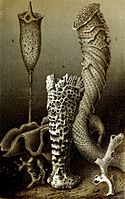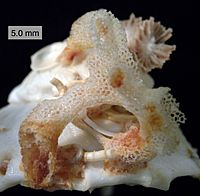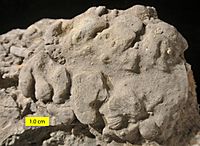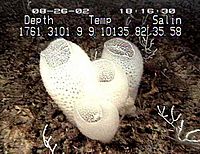Hexactinellid facts for kids
Quick facts for kids Hexactinellid spongesTemporal range: Cambrian - Recent
|
|
|---|---|
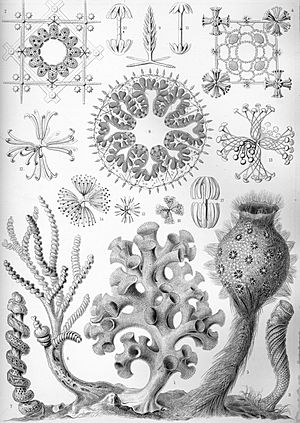 |
|
| "Hexactinellae" from Ernst Haeckel's Kunstformen der Natur, 1904 | |
| Scientific classification | |
| Kingdom: | |
| Phylum: | |
| Class: |
Hexactinellida
Schmidt, 1870
|
| Subclasses | |
|
Amphidiscophora |
|
Hexactinellid sponges are sponges with a skeleton made of four- and/or six-pointed silaceous spicules, often referred to as glass sponges.
Biology
Glass sponges are relatively uncommon and are mostly found at depths from 450 to 900 metres (1,480 to 2,950 ft) although the species Oopsacas minuta has been found in shallow water while others have been found much deeper. They are found in all oceans of the world, although they are particularly common in Antarctic and Northern Pacific waters.
They are more-or-less cup-shaped animals, ranging from 10 to 30 centimetres (3.9 to 11.8 in) in height, with sturdy lattice-like internal skeletons made up of fused spicules of silica. The body is relatively symmetrical, with a large central cavity that, in many species, opens to the outside through a sieve formed from the skeleton. Some species of glass sponges are capable of fusing together to create reefs or bioherms. They are generally pale in colour, ranging from white to orange.
Much of the body is composed of syncitial tissue, extensive regions of multinucleate cytoplasm. In particular, the epidermal cells characteristic of other sponges are absent, being replaced by a syncitial net of amoebocytes, through which the spicules penetrate. Unlike other sponges, they do not possess the ability to contract.
One ability they do possess is a unique system for rapidly conducting electrical impulses across their bodies, making it possible for them to respond quickly to external stimuli. Glass sponges like "Venus' flower basket" have a tuft of fibers that extends outward like an inverted crown at the base of their skeleton. These fibers are 50 to 175 millimetres (2.0 to 6.9 in) long and about the thickness of a human hair.
Reefs
The sponges form reefs (called sponge reefs) off the coast of British Columbia and Washington State, which are studied in the Sponge Reef Project. Reefs discovered in Hecate Strait, BC have grown to up to 7 kilometres long and 20 metres high. Previous to these discoveries, sponge reefs were thought to have died out in the Jurassic period.
See also
 In Spanish: Hexactinélidos para niños
In Spanish: Hexactinélidos para niños



